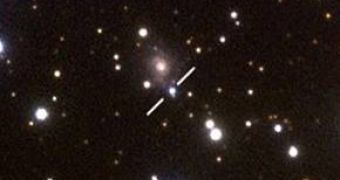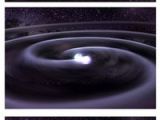The massive explosion of the Supernova 2006gz was at first thought to have been the death of a star, as it usually occurs, but high contents of heavy elements seem to shatter this idea. Located in a spiral galaxy named IC 1277, about 300 million light years away in the Hercules constellation, SN 2006gz shows strong evidence of an even more cataclysmic event. The merging of two white dwarfs.
A white dwarf is the remnant of a star too low in weight to trigger a supernova explosion at the end of its life. Towards the end of its life, the star loses control of the balance between the thermo-nuclear reaction taking place in its core and the gravitational force keeping the star from blowing itself apart. As a result of the increased nuclear activity, due to the lack of fuel to power itself, the star undergoes an expansion phase, multiplying its volume several thousand times, swallowing everything in its reach, after which it suffers a rapid compression and a explosion, shedding a large part of its gas.
The remnant core increases its density to reach extremely low volumes, some as small as the Earth's. White dwarfs are the result; incredibly hot, bright, small stars that process the rest of the small amounts of hydrogen gas, but mainly powered by a reaction that involves the nuclear fusion of helium, to create heavier elements such as silicon and carbon, essential to the creation of planetary systems.
Supernova explosions are classified into two categories: the explosion of young massive stars which cannot sustain themselves in such a configuration and need to be more stable, or as a result of a white dwarf stealing gas from a close by companion, only to trigger nuclear fusion reactions that usually do not take place in a white dwarf, and blows itself apart.
Astronomers first thought that SN 2006gz was just another example of a classic case of a white dwarf stealing matter from its companion. But further observations analyzing the light spectrum coming from it showed that high contents of carbon and silicon where present, evidence of two white dwarfs colliding.
The presence of two stars so closely together is not an unusual fact, evidence of stars forming at the same time in close proximity being present for years now. They orbit each other long after their birth, until finally, the gravitational pull brings them in a spiral of death, which will merge them together to form a new star or to destroy both.
The fact that SN 2006gz was brighter than scientists thought, suggests that its origins included more material than the 1.4 solar mass upper limit of a single white dwarf star.

 14 DAY TRIAL //
14 DAY TRIAL // 
